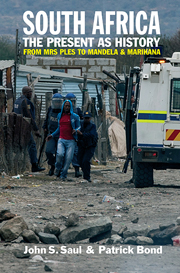Book contents
- Frontmatter
- Dedication
- Contents
- Introduction: South Africa in History
- Part I What's Past is Prologue: From the Beginnings to 1994
- 1 The Making of South Africa … and Apartheid, to 1970
- 2 The Transition: The Players Assemble, 1970–1990
- 3 The Apartheid Endgame, 1990–1994
- Part II The Present as History: Post-Apartheid and Post-1994
- Part III Conclusions: The Future as History
- Bibliography
- Index
3 - The Apartheid Endgame, 1990–1994
from Part I - What's Past is Prologue: From the Beginnings to 1994
Published online by Cambridge University Press: 05 December 2015
- Frontmatter
- Dedication
- Contents
- Introduction: South Africa in History
- Part I What's Past is Prologue: From the Beginnings to 1994
- 1 The Making of South Africa … and Apartheid, to 1970
- 2 The Transition: The Players Assemble, 1970–1990
- 3 The Apartheid Endgame, 1990–1994
- Part II The Present as History: Post-Apartheid and Post-1994
- Part III Conclusions: The Future as History
- Bibliography
- Index
Summary
On the one hand, as we have seen, capital (both local and global) was increasingly on side, its conviction growing that the ANC was the one force that could actually deliver an insurgent population to acceptance of a deal quite unthreat-ening in substance both to capital as well as to those whites who were securely lodged in the upper strata of society. On the other hand, however, there was the insurgent proletariat and precariat (as represented, notably, by COSATU and the UDF) : yet they too were being brought, slowly but surely, to heel by the ANC – the rank and file of both proletariat and precariat now to be rendered politically, as we have suggested above, as presumptive ‘citizens’ rather than as assertive and active comrades in a continuing struggle for genuine liberation.
The stage was thus set for ‘transition’ (however contradictory it might prove to be) … or was it? True, the ANC could look forward to the more public set of negotiations, those with the apartheid state, with some confidence – now that it had begun, by the late 1980s, to have acceptance of where it might, in the long run, really count: in the camp of that very capital with which it had, in fact, actually been negotiating for some years.
- Type
- Chapter
- Information
- South Africa - The Present as HistoryFrom Mrs Ples to Mandela and Marikana, pp. 121 - 142Publisher: Boydell & BrewerPrint publication year: 2014



